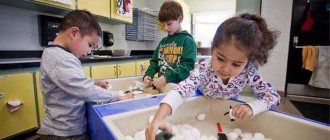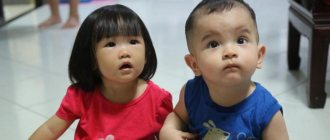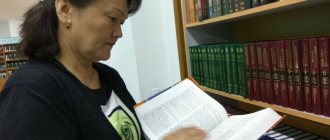A job description for a kindergarten teacher is needed as an addition to the employment contract, which explains its points. Although it is not mentioned in modern legislation, business practice and recommendations of regulatory authorities lead to the fact that most employers include it in standard labor documentation packages. As a legally binding document, this instruction must be correctly written and formatted.
- Form and sample
- Free download
- Online viewing
- Expert tested
FILES
Is a job description necessary?
A job description is not a mandatory act. Theoretically, a teacher can work quite successfully without this document. However, in practice, most employers still prefer not to abandon job descriptions. And this is a completely understandable trend, because it is easier for any employee to work when he clearly knows:
- what are the requirements for his position;
- what specific job responsibilities are assigned to him;
- what professional rights he is entitled to enjoy.
It is also beneficial for the employer that a job description be developed and approved for each subordinate specialist. With the help of the latter, the employer will be able to prove the legitimacy of:
- refusal to hire (the applicant does not meet the requirements listed in the instructions);
- application of disciplinary sanctions for failure to fulfill job duties (the employee does not perform or performs his duties improperly, although he knew about the need to perform them, which is confirmed by the employee’s signature confirming familiarization with the contents of the job description).
Main responsibilities
Let us list the responsibilities of a kindergarten teacher in the junior group and any other open in a preschool institution:
- exercise control over the life and health of children during their entire stay in the kindergarten;
- conducting various types of activities, developmental, sports, preparation for holidays, etc.;
- create a favorable atmosphere that promotes conflict-free communication between children;
- instill self-service skills in students;
- resolve conflicts, show restraint and tact with children and their parents;
- monitor the health status of pupils;
- immediate notification of danger and force majeure situations to immediate superiors or the appropriate service;
- undergo a medical examination according to the schedule.
IMPORTANT!
Some responsibilities in the nursery group of a kindergarten are different from what you have to do in junior or senior children. Children come to the nursery very young, often not even able to speak, they are not yet able to fully take care of themselves, and often cry. And in the younger group, the pupils are older, more responsible, and the majority have already undergone initial adaptation to new conditions. And if we talk about older people and “graduates,” then they need full-fledged training and development, and not training in self-service skills, like kids.
Profession "kindergarten teacher"
A kindergarten teacher is a teacher who teaches and educates preschool children (up to 7 years old). The main field of activity of representatives of this profession is related to organizing the stay of children in a preschool educational institution, conducting games and activities with children, monitoring their safety and health.
Teachers are in demand in state, municipal, private and departmental kindergartens, child development centers, as well as at home.
Teachers can work either independently, for example, in a small private kindergarten, or in a team.
The areas of professional activity of a teacher are education and service.
features of the activities of a teacher in a preschool institution article on the topic
Features of the activities of a teacher in a preschool institution.
A special role in the implementation of educational and educational functions is played by the teacher of a preschool institution. He is a specialist in the education, training and development of preschool children. A.I. Grigorieva defines a teacher educator as “an original creative personality, distinguished by a humanistic value orientation of his own existence, a high communicative and reflective culture; a professional capable of creating conditions for the development of a child’s personality, systematically seeing pedagogical reality, and applying modern educational technologies.” That is, certain requirements are imposed on the teacher’s personality; he must have special knowledge and skills, as well as certain personal qualities. Among them we can distinguish main and secondary qualities. Without the presence of the main qualities, it is impossible to become a highly qualified teacher, and these include, first of all, love for children, for educational activities themselves, the presence of special pedagogical knowledge, a high level of intelligence and general culture and morality, broad erudition, pedagogical intuition, as well as mastery of various teaching methods and raising children. Compliance with secondary requirements is not necessary for a teacher, but it contributes to more effective upbringing and education of children. The secondary (unstable) qualities include: communication, goodwill, cheerful disposition, predominance of a positive mood, good taste, etc. The combination of main and secondary qualities makes up the unique and original personality of the teacher. (Weiner 2001)
The priority of the personality of a preschool teacher is determined, first of all, by his responsibility to the age characteristics of the students, taking into account which is mandatory and necessary as in no other learning situation; it is due to the difficulties of the play form of learning, which corresponds to the leading type of activity of the child during preschool childhood, as well as the purpose and content of educational and developmental education. The teacher of a preschool educational institution must be humanistically oriented towards the development of the child’s personality through various means.
In addition, a teacher of a preschool educational institution must have certain knowledge: methodological - knowledge of the general principles of studying pedagogical phenomena, the laws of socialization of upbringing and teaching; theoretical - knowledge of the goals, principles, content, methods and forms of pedagogical activity and patterns of formation and development of the personality of a preschool child; methodological - knowledge of methods of raising and teaching preschool children; technological (knowledge of ways and techniques of raising and teaching preschool children.
Functions of a teacher in a preschool institution
The main functions of a teacher can be distinguished: educational, educational, developmental, normative, communicative, informational, coordinating, reflective and diagnostic.
The educational function is aimed at the conscious mastery by teachers of a preschool educational institution of didactic theory, a system of professional knowledge, abilities, skills, and social experience in the interests of the individual and society. This function is also aimed at satisfying information knowledge, because Currently, preschool institutions are called educational institutions. Theoretical and practical aspects of the implementation of the educational function of professional pedagogical culture ensure mastery of the content, organizational and methodological foundations for the upbringing and training of preschool children.
The developmental function lies in the fact that the improvement and activation of didactic knowledge and skills of educators occurs simultaneously with the development of professional thinking, memory and speech, pedagogical abilities, which allow the use and application of a more effective and creative approach in creating conditions for the harmonious development of children, the organization of educational educational process in a preschool educational institution.
The normative function of the professional pedagogical culture of the teacher regulates the teacher’s activity in the system. Knowledge of the norms of pedagogical activity gives the educator confidence in the correctness of his actions. Pedagogical norms, performing the function of values, help the teacher choose the most optimal ways of activity, establish ideals and professional priorities. The norms of pedagogical activity are aimed at resolving contradictions that arise in the process of interaction between the teacher and children, colleagues, parents and administration, at ensuring their cooperation and achieving joint actions in the upbringing of preschool children.
The information function in the work of a teacher is associated with all its functional components. The teacher must be oriented in the diverse flow of psychological, pedagogical and methodological information, be able to use various media, and master the means of information technology; be able to work with information using these means to meet personal and social needs.
The coordinating function of professional pedagogical culture lies in the variability of the content of the educational process and the selection of technologies. This function is the basis for improving his future professional activities. The educational function is associated with the implementation of the coordinating function.
Reflexive function. Reflection is associated not only with the educator’s understanding of his own pedagogical activities, but also with the assessment of the personal qualities, emotional reactions and cognitive abilities of the “reflector” by other educators, supervisors, and teachers. The effectiveness of the implementation of the function under consideration is closely related to the teacher’s presence of such qualities as critical thinking, the desire for analysis and evidence, the validity of his position, and the readiness to adequately perceive information.
Pedagogical reflection is a self-analysis of the activities carried out and an assessment of the results obtained. The teacher must be able to reflect on the reasons for successes and failures, mistakes and difficulties in the educational process in order to make changes in subsequent activities and achieve better results.
The diagnostic function consists of the ability to solve complex professional problems at a high level, comprehensively and creatively, namely: to build diagnostic goals, predict the results of diagnostic activities, select or develop diagnostic tools; together with other teaching staff (psychologists, music worker, speech therapist) carry out competent psychological and pedagogical diagnostics, analyze and interpret diagnostic data, design and implement the educational process based on system diagnostics.
Communication function. The communicative abilities of a kindergarten teacher are understood primarily as the ability to communicate, which has its own specifics in the field of pedagogical interaction. The teacher acts here as a subject of influence in interaction (direct and indirect) with the child and the children's community of the school; subject of personal and professional development of oneself (self-development) as an educator; the subject of the formation and development of the teaching staff as a team of educators; a subject of interaction with the family, representatives of society, social communities (institutions) that “reach out” to the child, stimulating the manifestation of their educational potential. Therefore, one of the important qualities of a teacher is the ability to organize long-term and effective interaction with preschoolers, and in addition, the ability to coordinate their activities with other participants in the educational process.
The teacher must be able to correctly assess the interaction situation, which consists of the ability to observe the situation, select its most informative signs and pay attention to them; correctly perceive and evaluate the social and psychological meaning of the situation.
The communicative abilities themselves include the ability to communicate with a wide variety of people; the ability to extract as much necessary information from communication as possible; the ability to prevent the occurrence of conflict situations, the ability to resolve conflicts that have already arisen; the ability to behave in such a way as to be correctly understood and perceived by other people; the ability to give another person the opportunity to express their interests and feelings. In addition, it should be taken into account that in the process of communication, along with verbal forms, non-verbal forms of pedagogical interaction play an important role, since non-verbal means of expression often carry a large amount of useful information.
It should also be taken into account that the educational process involves not only individuals (teachers, parents, children), but also various communities. It is necessary to distinguish between formal, structured, organized associations of people and informal, unstructured, event-based communities. The criteria for distinguishing such ideal structures as organizations and communities are in the features of unifying people. An organization is a purposeful association of people according to a predetermined structure; community emerges spontaneously. Relationships in an organization are determined primarily by the given nature of joint activities; in a community - by norms and values that are not given, but introduced by its members. Since in a preschool institution both organizations and communities need to arise in the team of teachers, it is necessary to pay attention to the formation of relationships between teachers, which is subject to many factors. The norms and values set by the nature of the work can change under the influence of introduced norms. Complex principles of interaction can also affect the educational process.
The educational function of a teacher’s professional and pedagogical culture reflects the area of educational activity. The teacher, on the basis of psychological, pedagogical and special knowledge, cultivates beliefs, motives, values, and norms of behavior in relation to surrounding people and the natural environment. In addition, educational activities are aimed at children and are primarily related to ensuring the personal, intellectual and physical development of the child.
The personal development of a child in a preschool educational institution consists of familiarization with universal and cultural values, the development of morality, positive personal qualities, the development of emotions and feelings, the development of social interaction skills, etc.
The intellectual education of a child is aimed at the development of cognitive processes, and is carried out through various cognitive and creative activities (drawing, modeling, games, design, etc.), minimal preparation of children for schooling is carried out.
Of particular importance is the organization of a child’s physical education in a preschool educational institution. In the preschool period, the basics of movement are mastered, a base of motor experience is created, from the elements of which all human motor activity is subsequently formed. (Ashikova S. 2004)
Bibliography:
- Ashikova S. Teacher and parents. Preschool education - No. 10, 2004 pp. 44-47
- Weiner E.N. Formation of a health-preserving environment in the general education system // Valeology.-2004.-No.1.-P.21-26
How to write a job description for a teacher?
The job description of a teacher is usually drawn up by an authorized person, for example, a lawyer or an employee of the personnel service of the department or department, the structure of which includes the preschool educational institution. Sometimes the manager of the garden himself is involved in the development of this document.
When drawing up a job description, it is necessary to take into account the current labor legislation, in particular the Labor Code of the Russian Federation, as well as:
- Professional standard “Teacher”, approved by order of the Ministry of Labor of Russia No. 544n dated October 18, 2013;
- Federal State Educational Standard for Preschool Education, approved by order of the Ministry of Education and Science No. 1155 of October 17, 2013;
- Sanitary and epidemiological requirements for organizations of education and training, recreation and health improvement of children and youth SP 2.4.3648-20.
If we are talking about a specialist in a state, municipal or departmental institution, then the job description must be developed in accordance with the professional standard. For private organizations, the requirements of the professional standard are advisory in nature. But you need to take into account that in any case, the work of a teacher involves contact with children, therefore specialized education and compliance with other legally established requirements (availability of specialized education, absence of medical contraindications, absence of a criminal record) is mandatory.
Developing a plan
The senior teacher is required to develop a work plan and daily schedule for the kids. Moreover, it is advisable to coordinate it with the parents. For example, at the first parent-teacher meeting, which is usually held before the start of the school year. With all this, it is necessary to take into account the behavioral characteristics of each baby and the development of children. And in accordance with the data received, think through an effective plan. In other words, it must take into account individual characteristics.
In reality, the situation turns out to be a little different. Lesson plans with detailed instructions are most often downloaded from the Internet, slightly edited (usually the name and address of the kindergarten, as well as the initials of the teacher “developer”) are edited and presented to parents. They, in turn, agree with everything. But the job responsibilities of a teacher include developing a correct and effective schedule of actions for the entire school year! And, as a rule, such plans cannot be edited.
In fact, it is very convenient to borrow someone else's designs. But children are all different. And they need a purely individual approach. Some people develop faster - they need more difficult classes (it’s better to give everyone something different), while others develop more slowly. Such kids will have to pay special attention. A good teacher should take these features into account and adapt a ready-made plan to the children. Or develop it yourself.
Job description structure
Since a job description is not a mandatory document, the law does not provide for any universal template. In fact, each employer has the right to independently develop a suitable form of instruction for him.
Very often, the structure of a job description is formed by the following 4 main blocks:
- general provisions;
- job responsibilities;
- rights;
- responsibility.
If desired or necessary, the contents of the document can be supplemented with other sections, for example, “Qualification requirements”, “Working conditions in the workplace”, “Procedure for making changes to the job description”, “Final provisions”.
Hygiene and medicine
The job responsibilities of the teacher also imply compliance by the employee himself with sanitary standards and hygiene rules. This also applies to children. That is, the teacher is obliged to monitor sanitary standards in the group, as well as the children’s compliance with hygiene rules.
You will have to worry about your health, both your own and your children’s. In other words, the employee is obliged to undergo a medical examination in a timely manner. And, in addition, take children for routine examinations. Usually there is a nurse or pediatrician right in the kindergarten building.
In addition, it is the teacher who is obliged to report suspicions of any disease, and also to show the child to the doctor if the baby is already exhibiting certain symptoms of the disease. When a child becomes ill, the teacher must also show him to the nurse in the kindergarten. If necessary, as already mentioned, you will have to call the parents, tell them about what happened, and also ask them to pick up the baby and show him to the doctor.
Contents of the job description
Next, we’ll look at what specifically to indicate in each section of the job description for a kindergarten teacher.
General provisions
In the first paragraph, indicate that this document was developed in accordance with current labor legislation, professional standards, Federal State Educational Standards and sanitary and epidemiological requirements.
Please note that this instruction is approved for the purpose of regulating the main job functions, job responsibilities, rights and responsibilities of the teacher, as well as his relationships and connections in his position.
Write down the mechanism according to which a kindergarten teacher is hired and dismissed.
In the next paragraph, list the requirements for a candidate for the position of teacher. Requirements can be taken from the professional standard. In particular, a preschool teacher must meet the following parameters:
- higher or secondary vocational education in the direction of “Education and Pedagogical Sciences” or higher or secondary vocational education and additional vocational education in the field of activity;
- undergoing preliminary and periodic medical examinations, extraordinary medical examinations, mandatory psychiatric examination (once every 5 years), professional hygienic training and certification (when applying for a job and every 2 years), vaccinations, having a personal medical record with the results of medical examinations, data on vaccinations and results of professional hygienic training and certification.
- no restrictions on engaging in teaching activities, as specified in Art. 331 Labor Code of the Russian Federation.
Next, you need to record who the teacher will report to during his work activity. This can be a senior teacher or the head directly.
Indicate that the teacher carries out his work activities in the kindergarten in accordance with this job description.
In the next paragraph, list the laws, regulations, as well as local regulations that guide the teacher in the process of work.
The next two blocks can be devoted to what a teacher should know and be able to do. It is better to write out the lists of necessary knowledge and skills in as much detail as possible. For example, a teacher needs to be well versed in the basic patterns of age-related development, the basics of preschool pedagogy, the theory and methodology of educational work. A preschool teacher in the senior, middle or junior group must also be able to communicate with children, master teaching methods and forms, establish partnerships with parents, and much more.
Certification of teachers. Process Features
Of course, the junior teacher, the senior teacher, and indeed all responsible employees in the kindergarten are required to undergo timely certification. It is usually carried out every few years. In all this, the successes of the pupils are taken into account.
But, as a rule, there are no problems with this. Certification is carried out under the guise of passing a curriculum developed independently, as well as with the help of information from the parents of children studying in the kindergarten. The employee’s portfolio is also taken into account. Upon successful completion of the certification, the teacher can improve his or her qualifications. This is something that will help him in his work in the future.
Final provisions
In the last section, note that the employee must be familiar with the instructions upon hiring.
Indicate the number of copies of the document drawn up, and also establish who is responsible for monitoring the execution of the instructions.
The job description is approved by the head of the preschool educational institution. The fact that the employee has familiarized himself with the document is confirmed by the signature of the person being familiarized, which is affixed both on one of the copies of the instructions and in a special familiarization journal.








